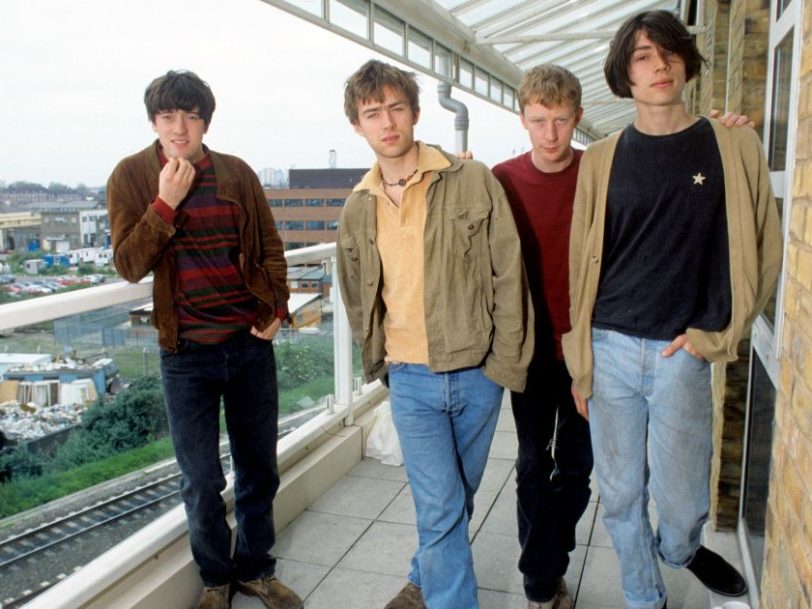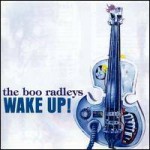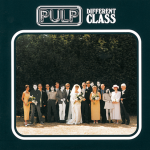On the (belated) occasion of Blur‘s relaunching as a working band, I’d like to examine the secret history of a group often described as the pinnacle of modern art-pop, looking at how their B-sides have complimented their history and the movements around them. A secret history to be mapped out like Damon’s associative skeletal, phantasmagoria’s on the historical cloth-map land of never-England on ‘This is a Low’. This is Blur’s ‘low’ lights.
You probably know the origins one way—a collection of blue-eyed megalomaniac drama-school misfits, louche francaphone boho’s and mumbly instrument savant daubers, plus a ginger guy from Colchester council in pyjama trousers create a rackety bag-of-bones collective of a band sounding like everything ‘from Handel to the Wedding Present via the Pixies and Specials AKA’. Proceed to play Camberwells a lot with some clatterly splutter-directed pogoing songs about being ‘long legged’ soaked in one pound mixers and half-digested ambition, loosely glued together by a bubbling talent still milky and fluid.
Then by 1991, Shoegazing was dominating the British charts. Rave and house had mixed with a nascent world-ambient–think FSOL’s ‘Papa New Guinea’. Baggy t-shirts and new-oval-gazing in fields with crusties and pylons; your music videos filled with purple visions, a nascent grunge sloppiness applied with art rock lipstick. Video’s have that grainy acid space vibe updated from the Ashes to Ashes video. Marketed as baggy, showgaze, pop and revivalist, the new Blur were still in the process of shaping themselves against record company pressure, with the callow though occasionally awesome Leisure and its see-sawing between pylon and buzz-star guitars, neo-sixties jangle and phoned-in back-dated spirit of ’90 zeitgeist ripping.
Taken from their own ‘Pop is Dead’, turgid and written-in-5 minutes-true story third single ‘Bang’ Luminous by contrast is floaty with undertones of distortion; a bucolic Bloody Valentine. An insistent loping melody-it exists n that chemical garden space common to the era. It’s lysergic lemon-flavoured dream-nod ran through your fingers like steam- a band still in the sense of crystallising its identity, it becomes an opaque c loud of faintly sensual vibes together with the saucer-lidded innocence of Tallulah Gosh suggestive of prelapsrian trips around the Moors and fields rather than rave cavorting. Guitars like pylons and all that- the pre or post come down from ‘sing’
But already, even as they were trading on the non-specific world-body world-mind trippy communioning altered states- ‘There’s no Other Way’s’ second side Mr Briggs foreshadowed a latent tendency towards observational evocations soon to find its expression in the Popscene era-demos and ossify within Modern Life is Rubbish. ‘Briggs’ is a sharpening of the daffy lolly pop; three chords tumbling after each other in a distracted sing-song row-a-boat, crashing straight insistent from the electric-glide fingers of Graham. And here the first attempts at ‘character’ study’; anecdotes about three-bar fires and ‘and ladies’-pinpointing nuances in the woodwork, in the varnish crack of a certain imaginary Britishness.
Moving towards 1992, as baggy, always the most contrived element of the blur sound- had run beyond formulaic and into-unfashionable, that melting soup magic dragon of influences in theri pockets turned to leaner sounds. Into speedier solutions to the problem of those buzzes in their heads and how to crack into hearts and heads and who knows what else.
A Ramones-esque mosh-head lyricised new-wave thrash feature of ’92 sets, Never Clever was supposed to be the second stage of Blur’s second-wave New Wave -career-launch pad, after Popscene. Post Popscene’s relegation to cult-hit– re-born years later in Friday-night indie-shed playlists– ‘Never Clever’ only resurfaced as an ill-produced demo-version- and as another heady brim of pop and high-octane sherbert confrontation with waskakwaka guitar vanishing points. With the descending breakdown extended into the eye of needle, with screeching pitch-shifts and then dreamy layered voices, it stands on the pinnacle of in context- a refreshing new-old sound.
By early 93 and after a series of record-company combustions and American-tour near meltdowns, the Modern Life is Rubbish era beckoned, at which point Blur began vary their attack still further; art-school garbs sutured with deeper harmonic sounds like sighs born from versions of suburban willowy angst, none more so than in Young and Lovely. Omitted from Modern Life is Rubbish, this off-beat g-minor piece with the swing chorus is oddly reminiscent of Damon’s ‘Musical’ roots—in the ‘West Side Story’ sense. Its cloistered sense of Britishness is matches fellow B-star ‘All your Life’ with its stories of ‘malls’ and ‘flies- pools of beer’, and in its pazzazo chorus’s the ineludible ‘Chemical World’ and ‘For Tomorrow’ with their headlong rush into a dream-capital. The verses meanwhile fix on suburban minutiae with a creepiness and luminescent mystery reminiscent of Cider with Rosie meets cult-British teen spook flick ‘Paper House-there’s something ritual, hence magical, about its floating invocations. It starts with snaking guitar line, then the synth led atonal countermelodies like cranes-or pylons amidst the suburbs whilst tinsel-shivering bells are free-form sprinkled half enchanting, half spine tingling, then enter those glissando Graham guitar tones sweet, chiming but with passive aggressive. A sound reminiscent, like ‘All your Life’, of Scary Monsters era Bowie’s mix of -hyper modern and the weird exoticism of post-sixties build estates with the wilderness of streams, thicken and hillock cries in the distance. Then a middle-eight with an insistent hammer on effect, and sighing vocals woven into the fabric, and the mysterious ‘why d’you do it’ plaintive and drowning as quick sand It’s tapping into the Aeolian hidden chemistry of common life with that intoxicating hazy passing shade of unlocked cabinets—the scent of whisky, slapdash perfume and necking –like the teenage-wildlife style Pulp and Suede songs emerging from this era. Just then Modern Life is Rubbish’s pen portraits were sharpening and puncturing this magic windowless house of subculture to let the sunlight of popular acclaim flood in.
Onwards they sped, post Westway and into – a Universally beautiful mongrel-melting joyous imaginary Britishness of Parklifes and Badhead’s. From Metroland and London Fields to music-halls and Jazz-age novellas in the long grass pims-cool shade, above and beyond the early twenties stories of the capital from dingy dingerwell flats and Good-Mixing. Notable was ‘Peter Panic’-along with ‘Blue Jeans’ on MLIR Blur’s most explicit Bowie allusion up to then—trippy star-dweller matiere a call back to the sixties freak-out secular liberation theology space race, and ‘Threadbare Street’ as nervous XTC understated paean to the placebo pill-beauty of the stock-market. But best of their escaped melodies/ studies in escape was Theme for an Imaginary Film.
Flowing into this period with it’s European influences – as also in the case of companion B-side Ist Schmidt and its Kurt Weill affectations, and ‘To the End’ with its chanteuse- – ‘Theme’ offered a broader new-wave vision-like the British Nouvelle Vague film directors with their Parisian antecedents. This sounds like south of France peasant folk songs arranged by Serge Gainsbourg against a stage painted sea of green and yellow; In terms of Damon’s writing the role-playing dramatic personae hovers daintily between the high Romanticism paean of To The End— it could be him, them, anyone on the tip of that universal language– and those arms-length character dissections of cross-dressing Mr Quangos and Mr Jacks. Gallic turns Romance De la Rose as with some phantom accordion, wheat in mouth, he promises to ‘woo you in rhyme’- the strings squeak with countryside tunes with faint choral tinges, but with a rough-hewn squeak like Diderot bedsprings along with the dreaminess. A circus-like middle-eight with buried guitar twangs with the choir parps ; it’s a straight psycho-geographical biplane line over ‘the high forties’ on the Channel from the Essex heartland into Merlaux haystacks and layers of continental memories– rather than ‘Magic America’. And then like buried corn eyes in the eiderflower and berry-wine, chemicals in the scent of hay Theme tears one back to the ‘London fields’ so predominant in Albarn’s thinking- and interview braggadio– during this period.
Then came that bitter-sweet 1995, from which we can take ‘Stereotypes’s number two and three– No Monsters in Me/Tame– as companion pieces. Although this period often gets critically sneered at as the tabloid-fuelled mini-nadir amidst the Blur Golden Age- hence disqualifying Leisure’s callow bubble-gunk bandwaggonisms– some of Brit-rock’s most discomforting melodies came produced in the conflict between musical stances on ‘The Great Escape’. So too there’s was an internal flux in the dynamic duo-another smearing and reconstructing of pop’s face surely as the surly-sweet Uncle Love and Never Clever updated vacant pop into thrashy new-wave. No Monsters stock lalala’s came coupled to a suitably horror-movie tense stop-start series of pick stabs to quivering fret-boards and some of the loosest playing in Graham’s oeuvre.
Produced during the Blur era, and a Song 2 b-side/bonus track ,1997’s Dancehall’s historic contradictions highlight the truth about this muddy and transitional period of cellotaped up re-friendships and a smashed ornament sound re-made like ceramic Dali. With it’s layers of distortion and glacial-alienating reverb soaked pace Dancehall should have epitomised the party line on Blur as a re-invention, but both in the reverb and in its ghostly melodies and talks of dancehalls with Wurlitzer melody corner it summons up fairgrounds and two-tone. Off ‘Blur’, the reclaiming of an original Blur essence, its layers of sound are first reminiscent of Blur’s first full incarnation-shoegazing. A shoegazing bookended by the sensual nastiness of MBV which begot the green-poppy veined ‘Sing’ and the distinctly rowdier churrhc-bell firing squad punk scrawl-up of the scene ‘Oily water’. ‘Tame’ and ‘No Monsters in Me’ , with their Surfer Rosa Pixies sonic monstrosities, showcased tendencies always present in Blur’s repressed/alter-ego night vision selves, which as any amateur Psych-student knows, are all just extended stories about beginnings. As ‘Death of a Party’s 1992 demo proved, there lay a bottled unrelenting melancholy– focused around a post-punk paen chord progression– just waiting for the germane moment to unleash the secret. Amongst Country House and the whimsical knees-up ditties, a cluster of renegade awkward tunes like ‘A Song’ lay stacked in uneasy harmony with a bunch of A-sides possessing their own mutated self-sabotaging tired-sad characteristics in some great meta-thing. Those off-cuts were pleas for help like Persephone’s black apples, like coded messages of worm-filled fruit and bits of sorry art.
From the Seymour era Blur had combined anarchy with nascent song-writing, and consistently sounded most comfortable in a skewed very Special(s) landscape- being a combination of bittersweet minor-chord floating melodies and the furious anhedonic flatness of Damon Albarn as Terry Hall’s vocals. Beneath notorious free-form monster Essex Dogs with its garage Amis were lyrical and musical phrases ‘planes of cemented-skies the colour of orangeade–drink your round’ hovering round a Fall -inflected verbal landscape, along with the refination of Jamaican dancehall beats into the staccato household appliance created muted ska-tones. Similarly, from sheet-noise rise up here ghost hymns for deserted palisades and promenades and broken-down party events with a soiled romanticism of luxuriant spaced-out failure. Somnulent and tangible as dust-dream figures in 9am light, they call across to ‘This is a Low’s soothing and soaring troubled dioramas. Though their most revolutionary period, the peculiar process of change in their music was tradition itself; like Bowie again, America and Iceland became the new Berlin; ‘Blur’ eclectic and still regimented by an essential metaphoric 4:4 as The Jam’s late -period PiL and soul co-opting.
By ’13’ and its mix-up of knotty prog-nocturnes and rhubarb-synth thrashes, Blur B sides dealt largely in remixes. A chief exception was the reworked ‘golden-age’ remnant All We Want, with its (career) nostalgic caramelly dreamy chamber pop merged with chopped-up scratches and bludgeoning atonal chords within, it becomes some mechan-organic fusion of the lush sounds and those new- floating rhubarb synths weapons amidst bird-sounds before a shift into limbo during the mid-eight. So the same old difference. Those sounds littering the treacle surfaces are once again reminiscent of the Fripp guitar pedal mutations of later Bowie, whose excursions into diffuse anti-verse chorus musical territory and restructuring-controversially-of classic line-ups were reminiscent of Blur’s later Think Tank sonic dislocations. That clattering-escalatory warp-mood also contains within it a melancholy revisitation from another star land-filled with those old sounds, over the simple re- modernisation as nostalgia aesthetic of ‘Blur’. Being essentially art-rock at their DNA- its more radical even as tinkling out of time pianos roll beneath the crescendo of orchestrated sound, reminiscent of ‘Look inside America’s sweeping but slightly angular face. Most of all they began to sound like a band ‘out of time’-and nothing could have been more collegial within that past-present lineage Albarn had been gimlet eyed heading towards, albeit with a few post-morning splutters and wheezes, than all those the Floydean/Kraut hermetics and collage production processes which could have time travelled from the experiment rooms and underground freak-zones in the U of L colleges 64-72. Especially hooked up to the kind of scuzz—from new Mississipi blues howlers passed around like sacred wine amongst people who would go on to become the Rolling Stones, through to the New York Dolls and Iggy worshiped like sects ’76 around London as punk brew, and into the Black/ Mascis spell cast on a wave of post post-punk, post Smiths nascent native bands looking for a new noise–think too of those early wild Tj’s Newport gigs for Nirvana — through which historically America’s own new -waves have shaken up and shacked up with our gor-blimey hued subcultures.
Finally on Think Tank’s A sides, that dense attack was fittingly stripped back into the kind of Afrobeat usually the provenance of former-art firebrand musicians floundering for ideas – Vampire Weekend excepted on the grounds of never being art or fire-anything– animated beyond the usual tasteful graceland shiny-happy sandaled caution by the thrusting hip-groove of Alex James’s ever-serpentine basslines and those same hidden sleepy melodies beneath the stark string-snap and under-production lurking beneath the feedback on the previous two records. Appropriate that Albarn would later collaborate with Clash bassist Paul Simonson, given that the Clash—and later Joe Strummer’s solo stuff— were the only other mainstream act to take on the form and—faults and all—make it sound like an artistic decision with warm blood in its veins and synapses on go. Hanging around the archives to re-appear on lead-up single Music is my Radar was ‘Into Another’, morphed into ‘Another/Headlist’. Mixing space effects with psychedelic-pop chord changes and an abrasive jittery watery undercurrent like the aftermath razed happy pomes in the morning after 13’s seven days of dark nights, it summoned up ‘Dancehall’ again—a meta-meta exercise. It called up the ‘Dancehall’ style melt down being played out in a real dancefloor; the underground former church crypt cellar-clubs in Camdenp—or for province pickers, the sound of Mosh Leicester’s infamous stained-glass gothic lower room on what we call a ‘playlist Syd-Barret’s fractured psyche circa 69” Friday—a sort of ‘light my- black incense- fire’ vibe. Which might sum up that essential, beautiful ambivalence to their music overlooked by fair-game critics, almost-overlooked by themselves at their fallow periods uintil you see from underneath the creative tension in their music unleashed when no-one was looking amidst the off-cut squiggles and baggy-material.
Now with the reunion, signals are mixed regarding a possible new album, with those law careers and flighty bassists joining new ordered New Order’s in September. But if it goes ahead, we should be as curious as to what they squirrel away for aficionado’s on track 3, perhaps what they unearth Death of a Party style to reinvent as funereal playlist come-down legend tracks, or just to witness that consistent adherence to the maddening and frequently prerogatives of Albarn and Coxon’s aural kiss-clash over the spirit of the art-school.
Originally written by Martin Goodhead and published on 30/07/2009




